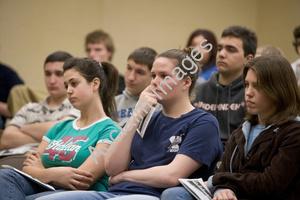Fostering Student Centered Learning (SCL) Through the Use of Active Learning Exercises in Undergraduate Research Methods Courses: Employing the Research Project Model.
Jeffrey A. Walsh, Ph.D. and Donna Vandiver, Ph.D.
Illinois State University
Criminal Justice Sciences
1. The Focus of the Project:
This work presents a semester long student centered active learning exercise--the research project model--employed in undergraduate research methodology courses followed by a post-test of student perceptions of skill competency. The research project model has proven successful in engaging students in actively learning substantive research methodology and has assisted in the learning of complex material. The work concludes with practical considerations for future project implementation based upon past experiences.A more complete version of the following discussion and information is forthcoming in the Journal of Student Centered Learning.

4. Student's Post-test Perceptions, Attitudes, and Perceived Competency:
Upon course completion students were assessed using 14 closed-ended scale-response questions addressing: student satisfaction with the course, with the active learning exercises, attitudes towards active learning, amount of time committed to this course as compared to other course, and their perceived understanding of research methods concepts.
Nearly half of the students (48 percent) indicated they spent more time on this course than their other courses. Time spent is not an indication of information learned but the instructor is pleased that students are putting in a fair amount of time to learn what is historically challenging material. The grade distribution of the classes indicates that time spent may be associated with learning via performance on exams and project assignments. Eighteen percent of the students (9) received A's in the course; 51(23) received B's; 26(12) received C's while a mere 4(2) received a D or an F.
Importantly, ninety-six percent of student respondents felt that actively "doing" research was more valuable than the passive lecture only teaching model. Eighty-seven percent of students felt the topic that the class chose was interesting. Seventy-four percent reported learning a lot about the topic. Eighty-seven percent agreed they increased their knowledge of conducting survey research as a result of the class project.
Students were asked (through open-ended questions) to identify the best/worst part of conducting their own research and the most/least valuable part of the project. The overwhelming majority of the students reported the project was valuable and enjoyed the experience. More specifically, one student stated, "It was a very valuable experience to do this project and I am really happy that I had the opportunity." Several students indicated a sense of ownership in the project. For example, one student stated "[The project] was ours; we thought up the questions, administered it, and played around with the numbers."
Many students indicated they enjoyed being active in the research process and applying what they had learned with one student noting, "being able to put the terms we learned into our own research."
Despite an opportunity to anonymously indicate worst/least valuable part of the research project few students did so. The issues that did emerge included: limited amount of time to actually conduct the research; not enjoying administering the surveys; the cumbersome nature of the literature review; and reliance on fellow students work and collected data.
Student's Perceived Competency
Eighty-nine percent of students indicated they felt they could conduct a small survey if asked to do so by an employer. The majority of the students indicated they either improved a specific skill or learned a new one altogether. For example, sixty-seven percent indicated they improved their library skills. Forty-six percent improved their ability to distinguish between scholarly and non-scholarly articles. Eighty-three percent improved their ability to write a technical paper. Ninety percent indicated they had never used a statistical software program and had increased their skills in that area as well.

2. What is Active Learning?
Active learning is defined as talking, listening, reading, writing, and reflection through problem-solving exercises, and other activities all with the objective of requiring students to apply what they are learning (Meyers & Jones, 1993, p. xi).
A great deal of research supports active learning exercises finding that students who are actively involved in the learning process are much more likely to retain information (Felder & Brent, 1996; Gardiner, 1998; Knowles, 1998; McKeachie, 1994), comprehend material (Bonwell & Sutherland, 1996; Robinson, 2000), and maintain overall interest in the course (Taylor, Anderson, & McConnell, 2003). The benefits of student centered active learning has been well-documented; it serves students well when they enter their ever changing fields of employment and need to adapt to change, think critically (Felder, 1993), and work both collaboratively and independently.
Many of the approaches expressed here are related to cognitive psychology and constructivist learning theory. Constructivism holds true that learning is idiosyncratic, active, and an evolving process (Anthony, 1996, p. 349). An environment must be created in which students are allowed to think for themselves as opposed to learning from a set curriculum (Rhodes & Bellamy, 1999).
Active Learning and Research Methods:
While a great deal of literature documents the benefits of using student centered active learning techniques in various academic settings and courses (Greek, 1995; McKinney, 2005; Robinson, 2000; Silberman, 1996), few efforts have specifically addressed the utility of engaging undergraduate social science research methods students in a semester-long, tiered assignment, empirical research project, drawing on student centered active learning techniques (Hackett & Caunt, 1995) and even fewer have studied methods courses in the field of criminal justice. Criminal justice research methods material is uniquely conducive to student centered active learning as part of a dynamic project based learning process in that many of the key constructs of the material require not only recognition, but application to real-world research dynamics.
Most research projects include unique circumstances in which "text-book" examples may not perfectly fit; therefore, a true understanding of how research can be carried out without sacrificing the reliability and validity of the findings is needed.

5. Faculty Assessment and Conclusions:
The post-test survey responses and open ended feedback provided by the students has shown, overall, that the research project model is an effective component to use in conjunction with lecture-based material for research methods courses. More specifically, it corroborates previous research findings on the use of active learning strategies. For example, Qualters (2002) reported students will often take ownership and interact more when courses and projects emphasize active learning.
In addition to supporting findings from previous research, this work also found it useful to allow students to evaluate the teaching strategy. The students were able to identify aspects they found helpful (e.g., how to operationalize research concepts, how to develop and administer a survey, how to analyze data, and how to work with SPSS) and areas they felt could be improved (e.g., conduct fewer surveys and have more control over the research topic the class chose).
Each semester, as the authors devise new remedies for old problems, new problems emerge; the research project evolves each semester and there are endless opportunities to continue improving the assignments, coordinating information, and maximizing student's learning of complex material. The problems that typically emerge include a deficiency in writing skills, an inability to use library sources accompanied by an over reliance on non-scholarly internet sources, wildly varying degrees of computer literacy combined with data entry and analysis problems. Trouble-shooting individual student issues can be very time consuming for faculty who may benefit from a graduate student teaching assistant in this course.
In the future, classes may choose more than one topic to accommodate more student interests. Some of the individual exercises and research tasks may be delegated to small teams rather than to all individuals. Additionally, feedback has revealed that students could benefit from more time in the computer lab learning how to use the statistical software program (SPSS). In response students next semester will be given short assignments and perhaps lab time to become familiar with the different capabilities of the software; thus, when students analyze their own data, they will need less formal instruction.
Overall, student centered active learning strategies have proven beneficial in teaching research methods and the tasks involved from project inception through completion seem to draw on the constructivist learning theory perspective. With the instructor serving as the facilitator, students were encouraged at each step of the project to ask and answer their own questions. Students indicated a sense of ownership in their projects and felt both more compelled and more confident in conducting their own research.
The level of student perceived confidence and competence in their research skills is encouraging. There are boundless opportunities available to implement student centered active learning activities in research methods courses through the use of the project model approach. While there are logistical issues to employing some of the active learning activities discussed here the student feedback and perceived learning outcome is well worth the effort.

3. The Semester-long Research Project:
Phase 1: Selecting a Topic. Students were encouraged from the first day of class to take ownership of the research project and this was in part facilitated by making the students responsible for the campus based project topic. Topics were kept broad enough so that most/all students could find an aspect that interested them.
Phase 2: Write a Literature Review. Students were taught about the purpose of doing a literature review and were given hands-on library instruction on conducting library research using the various electronic data sources available. Student's work was returned with an opportunity to submit a revised product as part of the final project.
Phase 3: Compose a Series of Closed-ended (yes/no, Likert, or Scale Response) Survey Question. Students developed their own questions for potential inclusion on the final survey questionnaire drawing on prior literature and personal interest. The entire class edited and vetted the questions democratically deciding on the final questionnaire.
Phase 4: Administration of Ten Surveys (Convenience Sample), and Data Entry. Students were given one week to administer ten surveys using convenience sampling. Emergent issues were addressed in class such as definitional problems, question sensitivity, and unanswered questions. Class-time was spent in the computer lab allowing students to create a shared database in which each student entered their own data into a statistical and data management program (SPSS) for later data analysis. A template code sheet was established as part of an in-class research activity.
Phase 5: Data Analysis. Directed lecture focusing on the relationship between variables, measures of central tendency, frequencies, descriptives, correlation, cross-tabs, and interpreting data (univariate, bivariate, multivariate) were presented. Statistical techniques demonstrated were limited to frequencies, descriptives, bivariate correlation, and cross-tabs given the methodological focus of the class.
Phase 6: Writing the Final Report. Upon completion of the data analysis students pulled all pieces of the project together to create an individualized final project containing an abstract, introduction, literature review, methodology, analysis, discussion, and reference sections with accompanying tables, graphs, and appendices. Students were expected to have made any necessary revisions to their literature reviews.

References and Additional Sources of Information:
Anthony, G. (1996). Active learning in a constructivist framework. Educational Studies in Mathematics, 31(4), 349–369.
Benson, A., & Blackman, D. (2003). Can Research Methods Ever Be Interesting? Active Learning in Higher Education, 4(1), 39–55.
Bonwell, C. C., & Sutherland, T. E. (1996). The active learning continuum: Choosing activities to engage students in the classroom. New Directions for Teaching and Learning, 1996(67), 3–16.
Caulfield, S. L., & Persell, C. H. (2004). Teaching social science reasoning and research principles: The role of groups and active learning. Presented at the International Society for the Scholarship of Teaching & Learning Conference, Bloomington, IN.
Chermak, S., & Weiss, A. (1999). Activity-based learning of statistics: Using practical applications to improve students’ learning. Journal of Criminal Justice Education, 10(2), 361–372.
Faust, J. L., & Paulson, D. R. (1998). Active Learning in the College Classroom. Journal on Excellence in College Teaching, 9(2), 3–24.
Felder, R. M., & Brent, R. (1996). Navigating the Bumpy Road to Student-Centered Instruction. College Teaching, 44(2), 43–47.
Greek, C. E. (1995). Using active learning strategies in teaching criminology: A personal account. Journal of Criminal Justice Education, 6(1), 153–164.
Hackett, G., & Caunt, D. (1994). Quantitative methods: an active learning approach. Oxford, UK; Cambridge, MA: Blackwell Business.
Maxfield, M. G. (2005). Research methods for criminal justice and criminology (4th ed.). Belmont, CA: Wadsworth Thomson Learning.
McKeachie, W. J. (1994). Teaching tips: strategies, research, and theory for college and university teachers (9th ed.). Lexington, MA: D.C. Heath.
McKinney, K. (2005). Active learning. Normal, IL: Illinois State University, Center for the Advancement of Teaching.
McMillan, J. H., & Forsyth, D. R. (1991). What theories of motivation say about why learners learn. New Directions for Teaching and Learning, 1991(45), 39–52.
Meyers, C. (1993). Promoting active learning: strategies for the college classroom (1st ed.). San Francisco: Jossey-Bass.
Qualters, D. (2002). Do students want to be active? Journal of the Scholarship of Teaching and Learning, 2(1), 51–60.
Robinson, M. B. (2000). Using active learning in criminal justice: Twenty-five examples. Journal of Criminal Justice Education, 11(1), 65–78.
Rosell, M. C., Beck, D., Luther, K., Goedert, K., Shore, W., & Anderson, D. (2005). The pedagogical value of experimental participation paired with course content. Teaching of Psychology, 32(2), 95–99.
Silberman, M. L. (1996). Active learning: 101 strategies to teach any subject. Boston: Allyn and Bacon.
Taylor, R. B., Anderson, T., & McConnell, P. (2003). Competencies and interest in a problem-focused undergraduate research methods criminal justice course: Two assessments. Journal of Criminal Justice Education, 14(1), 133–148.
This work is licensed under a Creative Commons License
This electronic portfolio was created using the KEEP Toolkit™, developed at the
Knowledge Media Lab of The Carnegie Foundation for the Advancement of Teaching.
Terms of Use - Privacy Policy